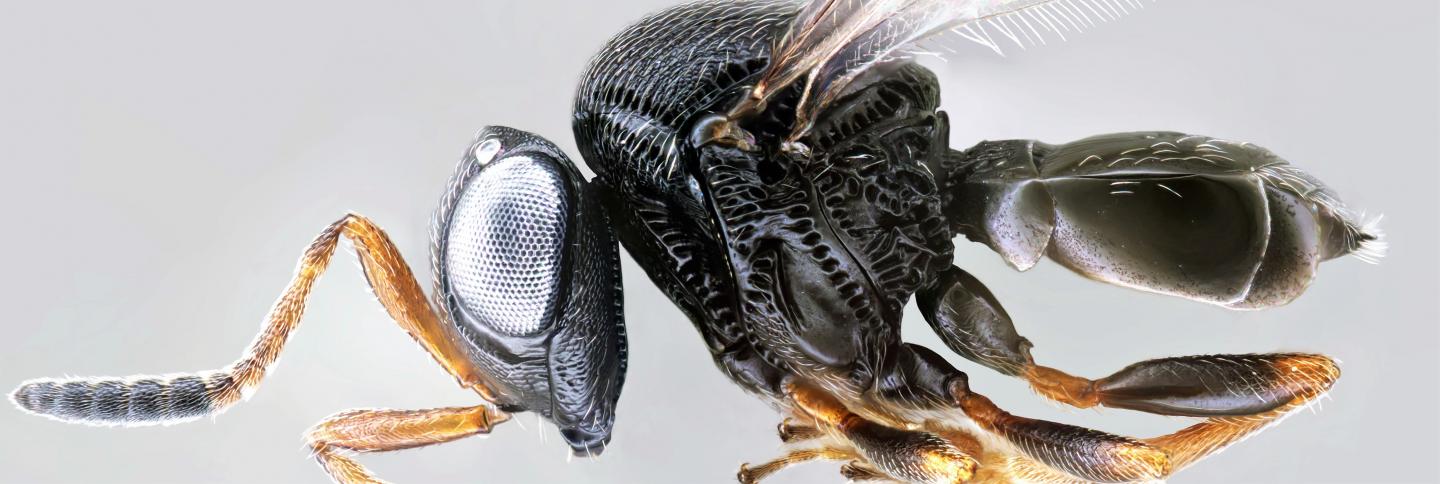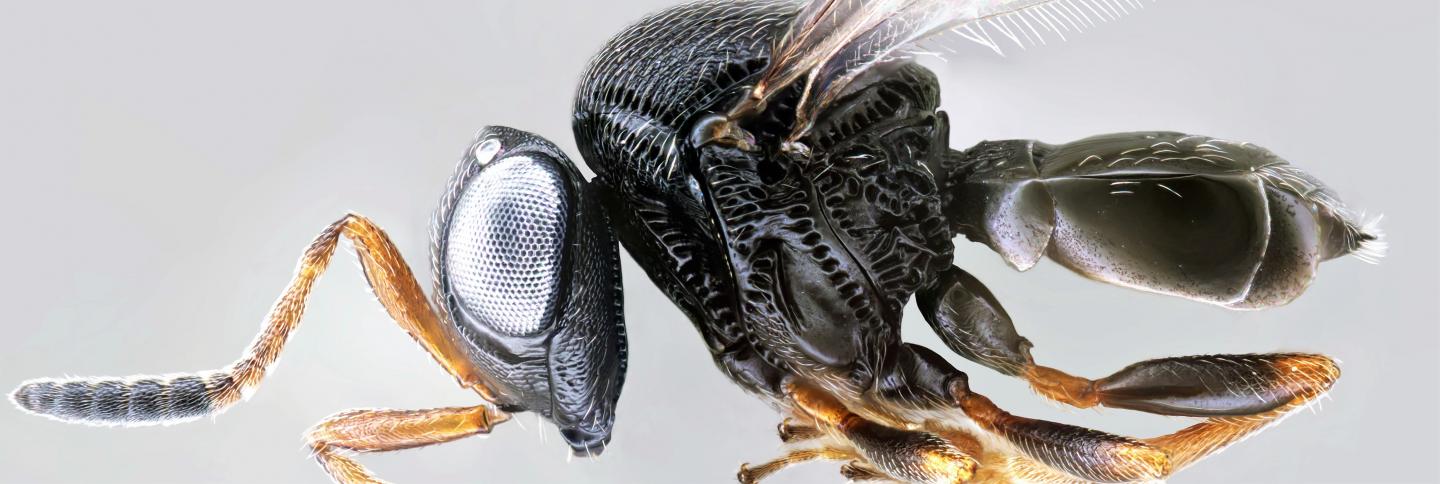
Credit: Elijah Talamas
In the paper 'First discovery of adventive populations of Trissolcus japonicus', published in the Journal of Pest Science, the CABI scientists outline how – after a survey of native egg parasitoids of the brown marmorated stink bug – they discovered the Trissolcus japonicus was already present in apple orchards in the Canton Ticino, southeastern Switzerland.
MSc Stahl and Dr Haye confirm that the wasp is now established in Switzerland, that it was found in two consecutive years at three different sites, and that it is the first time it was recovered from exposed H.halys egg masses in Europe.
The brown marmorated stink bug is a global pest which in 2016 caused $60m worth of damage to Georgia's hazelnut (a third of its crop) and in 2010, $37m worth of apples were destroyed in parts of the USA. CABI is leading the fight to see if Trissolcus japonicus can be used as a natural enemy to control the pest.
Accidentally introduced Trissolcus japonicus populations were also found in the north-eastern USA in 2014, and the wasps is now spreading throughout the country. It is known to search for hosts on trees and CABI is also conducting experiments in China to see if if attacks brown marmorated stink bug eggs in field crops.
In 2017, MSc Stahl and Dr Haye conducted the first set of laboratory tests, exposing egg masses of native European stink bugs to Trissolcus japonicus under quarantine conditions. The aim is to see if the wasp can be an effective and save biological control method to fight the brown marmorated stink bug if released in Europe.
Dr Haye said, "It is difficult to say for certain how Trissolcus japonicus arrived in Switzerland – the 2mm big wasp was probably accidentally transported from its native range along with the pest.
"But whether Switzerland was the actual country of introduction or whether the wasp was introduced into the climatically highly-suitable northern Italy before spreading northwards remains unclear."
Dr Haye added that while it is too early to evaluate the impact of Trissolcus japonicus on invasive brown marmorated stink bugs in Switzerland, based on the very high parasitism levels of H.halys eggs observed in Asia, its establishment could have the potential to reduce invasive stink bug densities below economic thresholds.
Dr Haye said, "Further research is needed to determine the current distribution and spread of Trissolcus japonicus and to evaluate how egg mortality may affect the H. halys populations and native non-target stink bugs in the near future."
###
Notes to editors
Full paper reference:
Stahl, J, Tortorici, F, Pontini, M, Bon, M, Hoelmer, K, Marazzi, C, Tavella, L, Haye, T, 'First discovery of adventive populations of Trissolcus japonicus in Europe*,' Journal of Pest Science DOI: 10.1007/s10340-018-1061-2 https://link.springer.com/article/10.1007/s10340-018-1061-2
*Note: this project received funding from the European Union's Horizon 2020 research and innovation programme under the Marie Sklodowska-Curie grant agreement No 641456.
Media contact: Wayne Coles, Communications Manager, CABI, email: [email protected] Tel: +44 (0) 1491 829395
Dr Tim Haye, Head Arthropod Biological Control, email [email protected] Tel: +41 (0)32 4214883
Additional information
Read the project page 'Biological control of the brown marmorated stink bug' to find out more about how Dr Haye is leading research** into using Asian or European natural enemies to control the fruit and nut pest.
**Note: this research was funded by Agriculture & Agri-Food Canada, European Commission and Ferrero. Partners include Agriculture and Agri-Food Canada and the University of Torino.
For more information on CABI's work on biocontrols visit: https://www.cabi.org/projects/controlling-invasive-species/biocontrol/
Related publications
Haye, T. and Weber, D. (2017) Special issue on the brown marmorated stink bug, Halyomorpha halys: an emerging pest of global concern. Journal of Pest Science.
Stahl, J. et al. (2017) Using the egg parasitoid Anastatus bifasciatus against the invasive brown marmorated stink bug in Europe: can non-target effects be ruled out? Journal of Pest Science.
Zhang, J. et al. (2017) Seasonal parasitism and host specificity of Trissolcus japonicus in northern China. Journal of Pest Science.
Mason, P.G. and Gillespie, D.R. (eds) (2013) Biological Control Programmes in Canada 2001-2012. CABI.
About CABI
CABI is an international not-for-profit organization that improves people's lives by providing information and applying scientific expertise to solve problems in agriculture and the environment.
Through knowledge sharing and science, CABI helps address issues of global concern such as improving global food security and safeguarding the environment. We do this by helping farmers grow more and lose less of what they produce, combating threats to agriculture and the environment from pests and diseases, protecting biodiversity from invasive species, and improving access to agricultural and environmental scientific knowledge. Our 49 member countries guide and influence our core areas of work, which include development and research projects, scientific publishing and microbial services.
We gratefully acknowledge the core financial support from our member countries (and lead agencies) including the United Kingdom (Department for International Development), China (Chinese Ministry of Agriculture), Australia (Australian Centre for International Agricultural Research), Canada (Agriculture and Agri-Food Canada), Netherlands (Directorate-General for International Cooperation, and Switzerland (Swiss Agency for Development and Cooperation).
Media Contact
Elizabeth Hawkins
[email protected]
49-622-148-78130
@SpringerNature
http://www.springer.com
Related Journal Article
http://dx.doi.org/10.1007/s10340-018-1061-2





